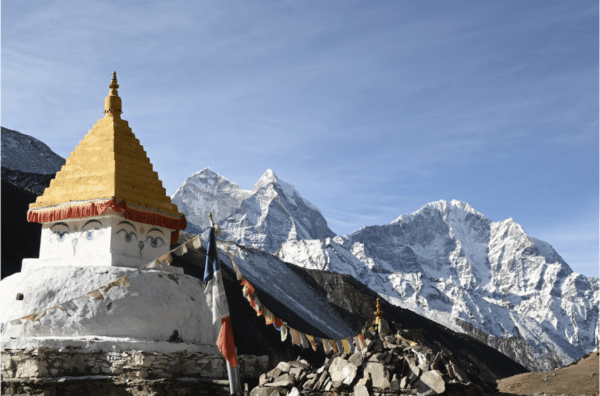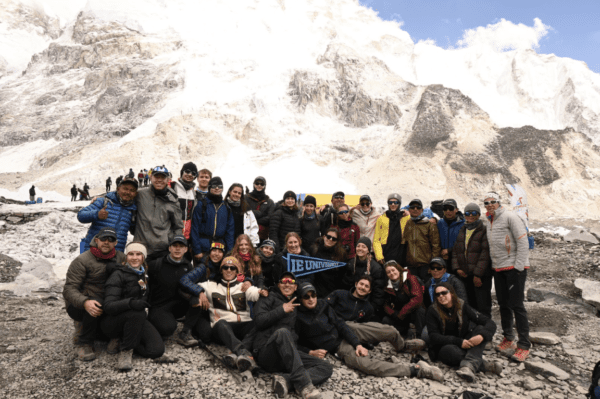During Spring break, second-year International Relations students, Angel Alonso (IE SPEGA Vice-dean) and Borja Santos (IE SPEGA Associate Vice-dean) embark on a journey to discover the wonders of one of the most secluded places on earth, the Khumbu Valley in the Sagamartha National Park in Nepal. The journey consists of a two-week trek through the Himalayas, in this edition, to reach Everest base camp. One of the main objectives of the journey organised by SPEGA (School of Politics, Economics and Global Affairs) is to develop a multicultural international perspective and leadership skills by applying them in real-world scenarios.
The Journey started on March 21st. Students met at Madrid Adolfo Suarez, ready to cross the globe without knowing what to expect from the experience. Soon, everybody got to know each other, and everyone was ready to board the plane that would embark us on an unforgettable, one-of-a-kind experience. Arriving at Kathmandu International Airport, students were introduced to their guide and mentor, Edurne Pasaban.
On May 17, 2010, Edurne became the first woman on earth to have climbed the 14th eight thousenders, the tallest peaks on earth. Edurne is not only a professional climber, but she is also a woman of solidarity with the communities of the Himalayas, a caring, empathetic, and inspiring woman, a mother of two children, and an exemplary leader, ready to inspire and guide the students on their journey of self-discovery. Lakhba, the leader of the Sherpa group, was in charge of logistics and guiding students through the mountain range; he accompanied us from our arrival in Kathmandu to the very last minute of the journey.
The first stage of the Journey: The gate of Sagamartha’s National Park
The Journey started early in Kathmandu. We woke up at 4 AM, packed our things, and drove to the domestic terminal of Kathmandu Airport to take our flight to Lukla, famous for being the world’s most dangerous airport. Tenzing Hillary Airport is surrounded by cliffs and mountain ranges that make the approach to Lukhla challenging for pilots; Lukhlas landing strip slopes uphill with a gradient of almost 12% to help aircraft slow down on a very short runway.
We walked through the tarmac to hop on two small aeroplanes which flew from the capital to the heart of the Himalayas, the gate to the Sagamartha National Park. The flight was only forty-five minutes, yet it was an incredible experience as we saw the sunrise over the Himalayan mountain range. After a successful landing in Lukla, we realised the journey had started; with a glimpse of the first Himalayan peaks and a beautiful sunrise, we started trekking through the journey’s first stage.
The first part of the journey consisted of a two-day trek to Namche Bazaar, a village on the Himalayas famous for being the hub of trekkers and the start of the hike through valleys and mountains to get to Everest base camp. On our way to Namche, we slept in a cabin located in Phadking. The primary function of this tiny village at an altitude of 2,610 meters above sea level is to support tourism and trekkers with accommodations on their trek to Namche Bazaar.
The morning after, we started our journey to Namche. This steep trek takes around 7 hours, crossing suspension bridges, traversing dense forests and steep inclines, and crossing rivers descending from the Khumbu Valley Mountain Range. Reaching Namche Bazaar was challenging, yet our arrival was welcoming. It is a village that offers everything for trekkers, from Mountain equipment stores to coffee shops, restaurants and local bars where, of course, we had a night of having fun at the Hungry Yak, one of the highest bars on earth!
Namche Bazaar was our first acclimatisation destination, where we had to spend two nights to get used to the height; Namche was the place where we, for the first time, were immersed in the mountain range with 360 views of the glaciers and white rocky peaks.

The Journey Continues: Deep in the Khumbu Valley
After our days in Namche, we continued our trek towards Tengboche, a village in the Khumbu Pasanglhamu rural municipality located 3,867 meters above sea level. The small town is home to the Dawa Choling Gompa, a beautiful Buddhist monastery and the largest in the region.
Tengboche monastery falls within the Sagarmartha National Park, a UNESCO World Heritage site. This Tibetan monastery was destroyed multiple times, first by an earthquake in 1934 and the second time by a fire in 1989, where it was subsequently rebuilt through international cooperation.
After our cloudy arrival in Tengboche and visiting the monastery, we spent the night in a lodge with views of the Gompa. The Sunrise in Tenghboche welcomed us to a bluebird day, sunny and warm; waking up here was incredible as our cloudy arrival at the site didn’t let us appreciate the views the village offers, located at the feet of tall rocky glaciers and with our first views of the Ama Dablam, one of the most beautiful glacier peaks I’ve ever seen in my life.
After a night next to the Buddhist masterpiece, we continued our trek to Dingoche; this trek is where the landscape started to change; higher up in the Himalayan range, the number of trees decreased, and the landscape changed to a rocky valley surrounded by glaciers and peaks, Dingboche was our second acclimatisation destination located at 4,410 meters above sea level, Dingboche is the best place to rest during the Everest base camp trek, it is one of the most popular trekking destinations where Sir Hillary and Tenzing Norgay set foot on their way to the Mt. Everest summit.

The village is located at the feet of the Amada Blam; the sunrise illuminates the glacier’s peak every morning in yellow tones, playing with the dark shadows of an early morning. This destination was vital in getting used to the height. Some students faced altitude sickness, a usual symptom after reaching 4,000 meters above sea level. However, with the help of Edurne, Angel and our sherpas, we overcame all challenges and continued our trek through the Khumbu Valley.
Stepping into the third stage of the journey: Higher up in the Himalayas
The journey’s Final Stage consisted of a four-day hike to reach Everest base camp. This trek was the best part of the trip as it involved crossing valleys surrounded by glaciers and, at the last step, crossing the Khumbu Glacier to get to Everest Base Camp at 5365 meters above sea level; the four-day trek started in Dingboche and continued to Lobuche, where we spent one night and then to Gorakshep, the closest village to Everest base camp.
Getting to Gorakshep was the most challenging part of the journey, as altitude reduced our physical condition and made the trek tiring. In the final trek from Gorakshep, we could see Everest base camp far away, and we knew we were approaching our last stage and reaching our goal. After a long trek through rocky terrain, we finally reached Everest Base Camp; it was a moment of success and satisfaction to get it after a long trip.
Nevertheless, the journey didn’t come to an end at base camp, A hike to the Kahla Pattar was waiting for us the next morning, followed by a Helicopter back to the capital, where we spent 3 nights visiting the wonders the capital offers and getting to know the culture and charm of a bustling city that never sleeps.








